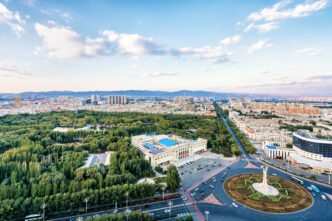Executive Summary
The Story So Far
Why This Matters
Who Thinks What?
Top economic officials from the United States and China commenced crucial trade talks in Kuala Lumpur on Saturday, aiming to de-escalate a burgeoning trade dispute and ensure a planned meeting next week between President Donald Trump and Chinese President Xi Jinping proceeds without disruption. The discussions, held on the sidelines of the Association of Southeast Asian Nations (ASEAN) summit, address recent retaliatory measures, including President Trump’s threat of new 100% tariffs on Chinese goods and China’s expanded export controls on rare earth minerals.
High-Level Discussions in Kuala Lumpur
U.S. Treasury Secretary Scott Bessent and U.S. Trade Representative Jamieson Greer are representing the American side, meeting with Chinese Vice Premier He Lifeng and top trade negotiator Li Chenggang. The talks are taking place at Kuala Lumpur’s Merdeka 118 tower, the world’s second-tallest building, though details about the meeting’s agenda or potential media briefings remain scarce.
The current talks represent a renewed effort to stabilize a delicate trade truce that has frayed in recent weeks. This truce, initially crafted over four previous meetings since May, was disrupted by an expanded U.S. export blacklist covering thousands more Chinese firms and China’s subsequent imposition of new global rare earth export controls.
President Trump had threatened new 100% tariffs on Chinese goods and other trade curbs, set to begin on November 1, in response to China’s actions. These measures mark a significant escalation, following a period where tariffs had been sharply reduced after a 90-day truce initiated in May.
Anticipated Trump-Xi Summit
The primary objective of the Kuala Lumpur talks is to pave the way for President Trump and President Xi to meet next Thursday at an Asia-Pacific Economic Cooperation (APEC) summit in South Korea. This high-stakes conversation is expected to cover interim tariff relief, technology controls, and Chinese purchases of U.S. soybeans.
Before departing the White House, Trump indicated he would raise several specific issues with President Xi. These include discussions about American farmers, the issue of Taiwan, and the case of jailed Hong Kong media tycoon Jimmy Lai, whose situation has become a high-profile example of China’s crackdown on freedoms in the region.
Analysts underscore the complexity of the current disputes. Josh Lipsky, international economics chair at the Atlantic Council, noted that U.S. officials must first find a way to mitigate disagreements over technology export curbs and China’s rare earth controls, which Washington seeks to reverse. Lipsky suggested that China might be reluctant to agree, as rare earths represent significant leverage.
Scott Kennedy, a China economics expert at the Center for Strategic and International Studies, emphasized the critical nature of the upcoming Trump-Xi meeting. Kennedy stated that the outcome would reveal whether China’s counter-restrictions have successfully balanced U.S. export controls or if an escalatory spiral will continue, with significant implications for global trade.
Trade Flashpoints and Past Agreements
The dispute over rare earths has been a central flashpoint, with China, the world’s largest producer, having previously cut off supplies to U.S. buyers in response to tariffs. China’s new controls, implemented on October 10, require export licenses for products using Chinese rare earths or related processing technology, citing a goal to prevent their use in military systems.
U.S. officials, including Bessent and Greer, have criticized China’s move as a “global supply chain power grab,” vowing that the U.S. and its allies would not accept the restrictions. The Trump administration is reportedly considering further curbs on software-powered exports to China, ranging from laptops to jet engines.
Adding to the tension, the Trump administration recently announced a new tariff probe into China’s “apparent failure” to meet the terms of the 2020 U.S.-China “Phase One” trade agreement. This agreement, which halted their previous trade war, involved China committing to significant increases in purchases of U.S. farm products, manufactured goods, energy, and services, targets that were ultimately not met.
Outlook on Bilateral Relations
The outcomes of these discussions in Kuala Lumpur and the subsequent Trump-Xi meeting in South Korea are poised to significantly influence the trajectory of global trade relations. They will determine whether the world’s two largest economies can avert a full-scale trade war or are set for further escalation, with broad implications for international commerce and stability.








